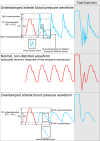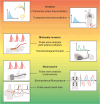Haemodynamic monitoring during noncardiac surgery: past, present, and future
- PMID: 38687416
- PMCID: PMC11164815
- DOI: 10.1007/s10877-024-01161-2
Haemodynamic monitoring during noncardiac surgery: past, present, and future
Abstract
During surgery, various haemodynamic variables are monitored and optimised to maintain organ perfusion pressure and oxygen delivery - and to eventually improve outcomes. Important haemodynamic variables that provide an understanding of most pathophysiologic haemodynamic conditions during surgery include heart rate, arterial pressure, central venous pressure, pulse pressure variation/stroke volume variation, stroke volume, and cardiac output. A basic physiologic and pathophysiologic understanding of these haemodynamic variables and the corresponding monitoring methods is essential. We therefore revisit the pathophysiologic rationale for intraoperative monitoring of haemodynamic variables, describe the history, current use, and future technological developments of monitoring methods, and finally briefly summarise the evidence that haemodynamic management can improve patient-centred outcomes.
Keywords: Anaesthesia; Blood pressure; Cardiac output; Haemodynamic monitoring; Heart rate.
© 2024. The Author(s).
Conflict of interest statement
KK is a consultant for and has received honoraria for giving lectures from Edwards Lifesciences (Irvine, CA, USA). KK is a consultant for Vygon (Aachen, Germany). RT performs consulting work on advanced monitoring technology for Medtronic, Edwards Lifesciences, and Philips Medical. RT received an investigator-initiated award from Apple to explore the use of exercise training in patients undergoing cancer surgery. RT has an NIH Grant (R-21, NIBIB) to develop near-infrared spectroscopy equipment to measure the oxidation state of cytochrome aa non-invasively. FM is the founder and managing director of MiCo (MichardConsulting.com), a consulting and research firm based in Switzerland. MiCo does not sell any medical devices, and FM does not own shares and does not receive patent royalties from any medical device company. BS is a consultant for and has received institutional restricted research grants and honoraria for giving lectures from Edwards Lifesciences (Irvine, CA, USA). BS is a consultant for Philips North America (Cambridge, MA, USA) and has received honoraria for giving lectures from Philips Medizin Systeme Böblingen (Böblingen, Germany). BS has received institutional restricted research grants and honoraria for giving lectures from Baxter (Deerfield, IL, USA). BS is a consultant for and has received institutional restricted research grants and honoraria for giving lectures from GE Healthcare (Chicago, IL, USA). BS has received institutional restricted research grants and honoraria for giving lectures from CNSystems Medizintechnik (Graz, Austria). BS is a consultant for Maquet Critical Care (Solna, Sweden). BS has received honoraria for giving lectures from Getinge (Gothenburg, Sweden). BS is a consultant for and has received institutional restricted research grants and honoraria for giving lectures from Pulsion Medical Systems (Feldkirchen, Germany). BS is a consultant for and has received institutional restricted research grants and honoraria for giving lectures from Vygon (Aachen, Germany). BS is a consultant for and has received institutional restricted research grants from Retia Medical (Valhalla, NY, USA). BS has received honoraria for giving lectures from Masimo (Neuchâtel, Switzerland). BS is a consultant for Dynocardia (Cambridge, MA, USA). BS has received institutional restricted research grants from Osypka Medical (Berlin, Germany). BS was a consultant for and has received institutional restricted research grants from Tensys Medical (San Diego, CA, USA). BS is an Editor of the British Journal of Anaesthesia.
Figures






References
-
- Teter CK. (1909) Thirteen thousand administrations of nitrous oxid with oxygen as an anesthetic. JAMA 448–54.
-
- Heard JDSA. A report on the electrocardiographic study of two cases of nodal rhythm exhibiting R-P interval. Am J Med Soc. 1918;75:238–51. doi: 10.1097/00000441-191802000-00007. - DOI
Publication types
MeSH terms
LinkOut - more resources
Full Text Sources
Miscellaneous

